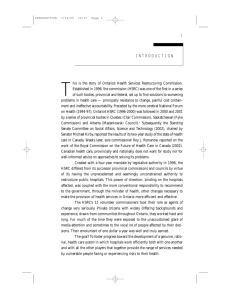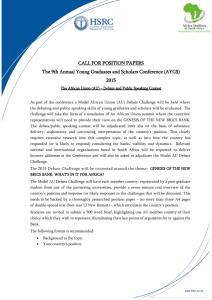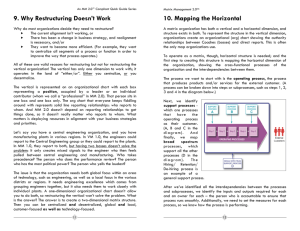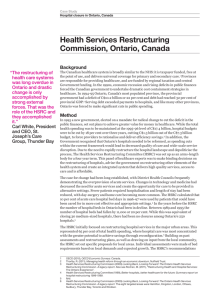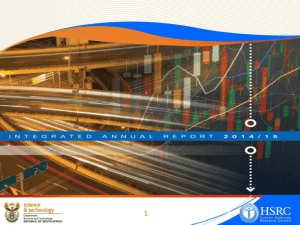Restructuring Health and Hospital Services: The
advertisement
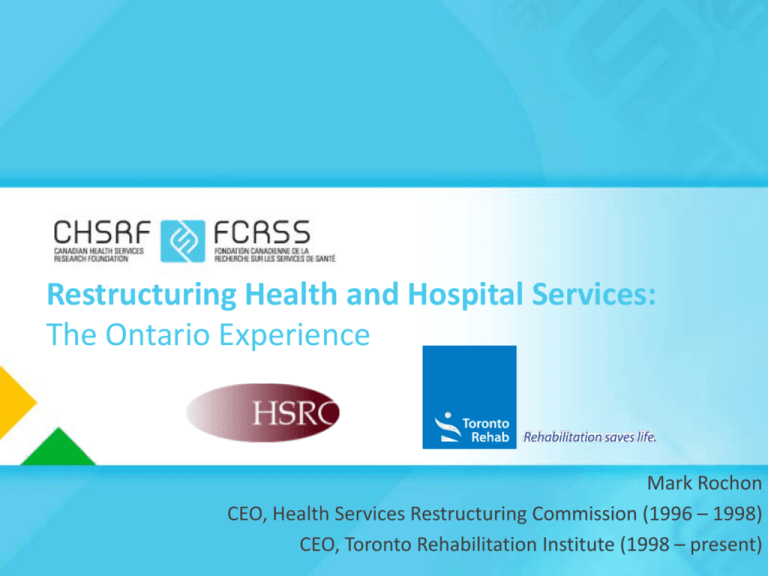
Restructuring Health and Hospital Services: The Ontario Experience Mark Rochon CEO, Health Services Restructuring Commission (1996 – 1998) CEO, Toronto Rehabilitation Institute (1998 – present) Conditions for Hospital Service Restructuring 1. Hospitals were in too much competition 2. Specialty hospitals should be affiliated with general hospitals 3. Hospitals were poorly distributed Report of the Select Committee of The House of Lords on the Metropolitan Hospitals (1892) 2 3 4 5 Antecedents to Change The Health Care Environment Pre-HSRC Changing practice and technology Reduced inpatient bed capacity Need for capital investment/renewal Incremental, unplanned change in early 1990’s Significant public government debt and deficits Growing financial pressures on hospitals and other health sectors Local DHC reports recommending change 6 Changing Practice & Technology Beds Staffed and in Operation 7 Type Number Acute 24,014 Psych 2,147 Rehab 1,890 Chronic 9,639 Private 714 Total 38,404 Changing Practice & Technology Comparison of Surgical Activity and Acute Separations: 1989/90 and 1995/96 1,500,000 1,125,000 750,000 375,000 0 Inpatient Surgical Day Surgery Source: MoH, Institutional Services Branch 8 All Surgery Total Acute Inpatients Change in Hospital Employment (FTE) 150,000 120,000 90,000 60,000 30,000 0 1989-90 1991-92 1993-94 1995-96 1997-98 9 1999-00 2001-02 2003-04 2005-06 2007-08 2009-10 Circumstances when HSRC was created New government elected on a change agenda Recognition of the need for change but “zealous” desire to protect the status quo Reasonable DHC hospital restructuring reports but no vehicle to implement Lack of appreciation for what HSRC would be doing 1994/95 Government of Ontario operating deficit $10.2 billion on revenues of $46 billion or 22% Government of Ontario accumulated debt increased from $39.3 billion in 1989/90 to $90.4 billion in 1994/95 or 32% of provincial GDP Government of Canada net debt 74% of GDP Debt service cost exceeded payments to hospitals 10 “I think it will be a clash between the political will and the administrative won’t ” Jonathan Lynn & Anthony Jay Yes Prime Minister vol. 2 (1987) 11 Why was the HSRC needed? Growing financial pressures Lack of clear accountability (or lack of governance-in-common) Inability/difficulty of local communities to determine their own fate Need to “de-politicize” decisions General recognition within the industry that change was necessary (as long as it was someone else) 12 13 Authority Under Section 6 (Public Hospitals Act): the Minister can direct a hospital to close, amalgamate the Minister can direct a hospital to provide specified services or cease to provide specified services the Minister can make any other direction to a hospital that he considers in the public interest to do so hospital board shall ensure that a direction is carried out and is deemed to have unrestricted power to carry out a direction Minister’s powers under s. 6 sunset after 4 years 14 Delegation of Authority ‘Unique’ delegation of powers based on legislative change(s)… “An independent body at arm’s length from the Government, empowered to develop, establish and maintain an effective and adequate health care system…” (Savings and Restructuring Act, Amendments to the Ministry of Health Act included in Schedule F) 15 HSRC Mandate To make binding decisions on the restructuring of hospitals To provide advice/recommendations to government on restructuring other elements of the health services system, including advice about reinvestment To create an integrated, coordinated health services system services of high quality access to necessary services affordable 16 HSRC Overall Approach Restructuring of hospitals in major municipalities (largest 8 communities comprising 65% of allocations to hospitals) Restructuring of hospitals elsewhere in Ontario Recommendations on restructuring other sectors/elements of the “system” Development of vision of a health services ‘system’ & development of a ‘strategic plan’ to achieve the vision 17 HSRC Process DHC reports reviewed local input invited HSRC establishes restructuring options and makes a decision on ‘best’ option Notices of Intention to Issue Directions issued and delivered to the affected institutions, together with reasons for the decisions. 30 day Notice period inviting representations to the Notices from any hospital and/or any other person or organization HSRC considers representations, undertakes additional analysis (as required) and issues final Directions If decisions not ‘carried out’ HSRC to notify the Minister 18 “Parallel Activities” addressed by HSRC to Support the Restructuring Mandate 1. Vision of the future system/context for change 2. Reinvestment guidelines 3. Northern/rural restructuring 4. Costing methodology to estimate savings 5. Governance 6. Human resources 7. Medical human resources 8. Policy advice on implementation 9. Policy advice on other system change 19 Communication Strategy Pre and post decision media engagement Consultation with key influencers Purchased advertising Media and briefings for politicians Communication materials for providers 20 21 Consequences and Reflections of HSRC’s Work 22 Consequences of HSRC’s Work Structural Change Amalgamation of 44 hospitals to form 14 new organizations Takeover of 4 hospitals by other hospital corporations Directed closure of 33 public, 6 private and 6 psychiatric hospital sites – 27 of public hospitals closed Now 150 hospital corporations, down from 225 in 1989-90 Creation of 14 JEC’s to provide shared governance to multiple organizations Creation of 18 rural/northern hospital networks Establishment of a variety of regional and/or provincial networks (child health, rehab, FLS) 23 Reflections on the Process of Restructuring There was an informed audience (insiders) across the province that recognized that health system change was essential and that difficult decisions had to be made Many communities had the desire and willingness to embrace change to prepare better for the future However, many inherently resist change and the loss of power/prestige Deficient data and information to plan for health services Rebalancing of health services through reinvestment in community services such as home care and long term care is essential Strong, consistent leadership is needed at the provincial/central level to steer health system reform 24 Political Accommodations Withdrawal in 1999 of Direction making authority Rural & Northern Health Policy Reversal of some directions 25 Lessons Learned What Worked Broke status quo mould – served as a catalyst of change Relied on local advice about what was possible – avoided one size fits all solutions Process – reduced risk of “wrong” decisions Resisted lobbying and political influence Persuaded government to invest in long term care and home care Labour re-adjustment strategies Stimulated large scale reinvestment in capital Move from autonomy to interdependence amongst providers 26 Lessons Learned What Didn’t Work No coordination in communication from government about need for a system and need to spend money wisely Delay in investment decisions Decision making and reality of the political calendar Leaving most policy advice development to phase II failure to persuade government to move forward with IT investments Some hospital boards should have been replaced Government should have coordinated its budget reductions with restructuring Process got in the way of timely decision Lack of local presence to respond to media/public concerns 27 Lessons Learned About Conditions for Change HSRC as a visible and powerful force for change Need to communicate the purpose of change Persistence – length of HSRC mandate Burning platform vs. everything ablaze Involvement of community leaders 28 Lessons Learned About Arms Length Agencies Effective means of making urgent decisions Delegating decision making authority does not diminish political accountability Who our friends were 29 30 Major System Changes Post HSRC Development of primary care organizations alternatives to F.F.S. Focus on wait time reductions Accountability Agreements E-health Local Health Integration Networks Excellent Care for All Act Move to service based funding 31 QUESTIONS? 32
